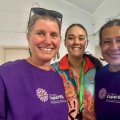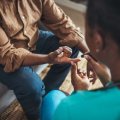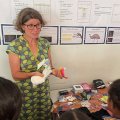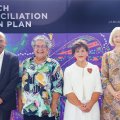The University of Queensland’s decades-long links with an Indigenous group, the Mornington Island Dancers, were strengthened when the group revisited the St Lucia campus recently.
The visit came 36 years after the dance troupe first came to campus in 1974 to perform for over 1500 schoolchildren, as well as University students and staff.
The first visit initiated the beginning of an important research and social relationship between Mornington Island and UQ, which has flourished over thirty years.
Aboriginal Environments Research Centre (AERC) PhD student Cameo Dalley, the organiser of the visit, said members of the group enjoyed a trip through the AERC archives.
“UQ holds a vast collection of material from Mornington Island, including photographs and documents at the Fryer Library and objects at the Anthropology Museum.
“Over the years during my fieldwork, Aboriginal research participants on Mornington Island have asked me for copies of photographs that we hold here at UQ,” she said.
“This visit provided an ideal opportunity for the group to discuss our ongoing research and to view and request copies of the photographs.”
Dancer Roxanne Thomas said she had returned to UQ a couple of times since the 1974 visit.
“I love coming here – I enjoy my visit every time. The thing we love best is seeing our photos,” Ms Thomas said.
She said she was fond of many UQ people, such as the Director of the AERC, Professor Paul Memmott, as they had known each other for many years.
“Paul went to Mornington Island when I was little and when he was a young man,” Ms Thomas said.
In 1974, when they were undergraduate students, David Trigger and Paul Memmott watched the dance performance with interest.
Today, David Trigger is a Professor of Anthropology at UQ’s School of Social Science, and Professor Paul Memmott is the Director of UQ’s Aboriginal Environments Research Centre which is based in the School of Architecture and the Institute for Social Science Research.
In the intervening years, Professor Memmott completed his PhD research on Mornington Island and supervised a number of students during the 1990s, assisting with a native title claim.
More recently, research on Mornington and the surrounding Wellesley Islands has been rejuvenated with an ARC Discovery Project titled “Isolation, Insularity and Change in Island Populations: An Interdisciplinary Study of Aboriginal Cultural Patterns in the Gulf of Carpentaria”.
The project is led from the AERC at UQ and as part of the study, a number of UQ researchers spent extended periods on Mornington undertaking fieldwork in the areas of anthropology, geomorphology and archaeology. Biologists and linguists from other universities are also involved.
The project has also included two UQ PhD projects being conducted on Mornington, one in anthropology by Cameo Dalley, and one in archaeology by Daniel Rosendahl.
Cameo Dalley said her PhD research focused on the social relations of people of Mornington Island.
“Some of the dancers and their families have formed an important part of my research,” Ms Dalley said.
One of the highlights of the dancers’ recent trip was that one of the 1974 group was again part of the visit this year.
Gordon Watt is now the senior songman with the Mornington Island Dancers and he is one of few surviving men who can sing in Lardil, the Aboriginal language of Mornington Island.
In addition to visiting the AERC archives, the group performed an impromptu dance beside the UQ lakes, entertaining special guests, staff and students alike.
Media: Cameo Dalley at the Aboriginal Environments Research Centre on 07 3365 3779 or c.dalley@uq.edu.au; Kim Jensen at the Faculty of Engineering, Architecture and Information Technology on k.jensen@uq.edu.au or 07 3365 1107.
.jpg)












